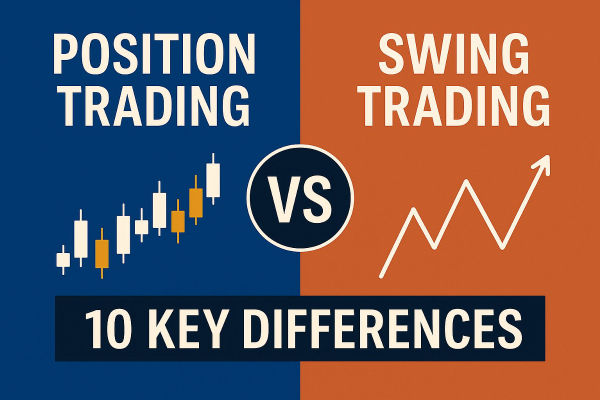Swing trading has become increasingly popular among traders who seek to capitalize on short to medium-term price movements in the financial markets. Unlike day trading, where positions are closed within a single day, swing trading involves holding positions for several days or even weeks, allowing traders to benefit from broader price swings. This strategy provides the opportunity to capture more substantial profits without the high-pressure environment associated with day trading. In this article, we'll explore what swing trading is, how it works, and essential strategies for achieving consistent success in this trading style.

Understanding Swing Trading
Swing trading is a trading approach that aims to capture price fluctuations—also known as "swings"—in various financial assets such as stocks, commodities, or currency pairs. Traders hold positions over short- to medium-term periods, typically ranging from a few days to several weeks, in an attempt to profit from upward or downward trends. This approach contrasts with both day trading, where all positions are closed within the same day, and long-term investing, where positions may be held for months or even years. Swing traders usually focus on technical analysis to identify the right entry and exit points in a trade.
Swing traders analyze price movements through charts and technical indicators such as Moving Average (MA), Relative Strength Index (RSI), and Fibonacci retracement levels. By identifying patterns and trends, they seek to enter trades at the beginning of a trend and exit before the trend reverses. This allows them to capture the middle portion of the price movement, maximizing potential profits.
Why Swing Trading is Popular?
Swing trading appeals to many traders because it strikes a perfect balance between the high-speed nature of day trading and the patience required for long-term investing. Its flexibility makes it ideal for those who can't focus the entire day to watching the markets but still want to take advantage of short-term trends. By holding positions for several days or weeks, swing traders can capitalize on larger price movements without the stress and pressure of constant, fast-paced trades. With more time to analyze market trends and make better decisions.
Another reason for its popularity is the potential for higher returns. Swing traders can capitalize on market movements that may take days or weeks to develop, allowing them to ride a trend for a more extended period and reap greater rewards. Additionally, swing trading offers more refined risk management strategies compared to the shorter timeframes in day trading. With longer periods to set stop-loss orders and take-profit points, swing traders have more control over their risk exposure.
Key swing trading strategies
To succeed in swing trading, traders must implement well-researched and tested strategies. Three commonly used strategies by swing traders are trend following, Breakout trading, and Fibonacci retracement.
The trend following strategy is one of the most widely used techniques in swing trading. Traders analyze the overall market direction and seek to open positions that align with the prevailing trend—whether upward (bullish) or downward (bearish). By using moving averages, trendlines, and Chart Patterns, traders can confirm the trend's strength and time their entry accordingly. For example, if a stock is in an uptrend, a trader might buy the asset and hold it until the price approaches a resistance level.
The breakout strategy involves identifying critical support or resistance levels in the market and waiting for the price to break through these barriers. A breakout often signals the start of a new trend, providing an ideal entry point. To confirm the breakout, traders often look for increased trading volume or other technical indicators that support the move. For instance, if a stock breaks above a long-held resistance level, swing traders will likely buy, expecting further upward movement.
Another popular technique is the Fibonacci retracement strategy, where traders use Fibonacci levels to predict areas of potential support or resistance. These levels assume that prices often retrace a predictable portion of a move before continuing in the original direction. For example, after a significant upward move, a trader may wait for the price to pull back to the 38.2% Fibonacci retracement level before entering a new long position.
Managing Risk in Swing Trading
Risk management is critical for swing traders, as holding positions overnight or for several days exposes them to potential market volatility. One of the most important aspects of risk management in swing trading is setting clear stop-loss orders. Before entering a trade, traders should decide how much they are willing to lose on a given position and set their stop-loss orders accordingly. This ensures that even if the trade moves against them, their losses are limited.
In addition to using stop-losses, portfolio diversification plays a significant role in minimizing risk. Rather than concentrating all their capital in a single trade, swing traders often spread their investments across multiple assets. This reduces the impact of any single trade on their overall portfolio performance. Traders should be also aware of the market-moving events and news that could cause unexpected price shifts. By monitoring economic releases, corporate earnings, and geopolitical developments traders avoid getting caught off-guard by large price swings.
Pros and Cons of Swing Trading
Swing trading offers several advantages that attract traders of all experience levels. One key advantage is its time efficiency. Since positions are held for days or weeks, traders do not need to monitor the markets constantly, as day traders often do. This makes swing trading a more accessible option for those who have other commitments, such as a full-time job. Additionally, swing traders can potentially capture larger price movements compared to day traders, who often profit from small intraday changes.
However, swing trading is not without its risks. One significant disadvantage is overnight risk, as holding positions for multiple days exposes traders to potential price gaps caused by after-hours news or events. For instance, an unfavorable earnings report or geopolitical development could drastically impact the price when markets reopen. Another challenge is that swing trading requires discipline and patience. Traders must stick to their strategy and avoid making emotional decisions based on short-term market fluctuations.
Conclusion
Swing trading provides a profitable middle ground between day trading and long-term investing. By focusing on capturing short- to medium-term market trends, swing traders can achieve consistent profits while avoiding the stress of day trading. Success in swing trading hinges on mastering technical analysis, employing sound strategies, and effectively managing risk. For traders looking to capitalize on market swings without constantly monitoring their positions, swing trading offers a flexible and potentially rewarding approach.
Disclaimer: This material is for general information purposes only and is not intended as (and should not be considered to be) financial, investment, or other advice on which reliance should be placed. No opinion given in the material constitutes a recommendation by EBC or the author that any particular investment, security, transaction, or investment strategy is suitable for any specific person.



























